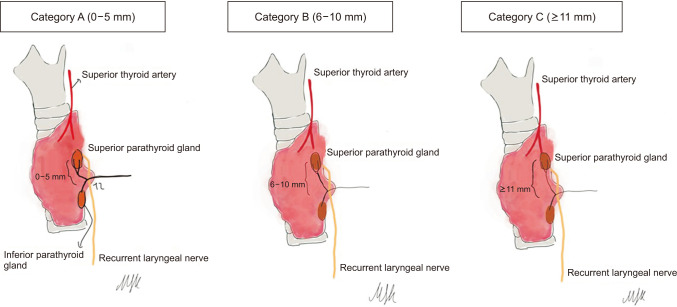Ann Surg Treat Res.
2024 Feb;106(2):63-67. 10.4174/astr.2024.106.2.63.
The use of superior parathyroid gland as an anatomical landmark in identifying recurrent laryngeal nerve during total thyroidectomy: a prospective single-surgeon study
- Affiliations
-
- 1Department of General Surgery, Uludag University Faculty of Medicine, Bursa, Turkiye
- KMID: 2552386
- DOI: http://doi.org/10.4174/astr.2024.106.2.63
Abstract
- Purpose
This study was performed to determine the anatomical position of recurrent laryngeal nerve (RLN) relative to superior parathyroid gland (SPG) in a consecutive total thyroidectomy series.
Methods
A total of 421 patients (mean age, 45.6 years; female, 76.0%) who had total thyroidectomy accompanied with intraoperative exposure of RLN in relation to SPG were included in this prospective single-surgeon thyroidectomy series study. The relation of RLN to SPG was assessed based on the measurement of the natural distance between the RLN and SPG, which was categorized as 0–5 mm, 6–10 mm, and ≥11 mm.
Results
Most of the thyroidectomy indications (69.1%) were related to malignant disease including papillary carcinoma in 54.9% of cases. Overall, in 90.7% of patients RLN was identified within 5 mm of the SPG, and in 65.1% of cases, it was found within 1 mm of the SPG. The RLN was found between 6 and 10 mm from the SPG in 8.5% of cases, while it was at least 11 mm away from the SPG in 0.7% of cases.
Conclusion
In conclusion, this prospective single-surgeon thyroidectomy series study indicates the likelihood of localizing the RLN in close proximity to SPG during total thyroidectomy operations. Hence, the SPG can be used as a landmark to identify RLN, and as part of routine parathyroid-sparing thyroidectomy, it may represent a convenient complementary approach to minimize the risk of iatrogenic injury to RLN in patients with an intact SPG.
Keyword
Figure
Reference
-
1. Christou N, Mathonnet M. Complications after total thyroidectomy. J Visc Surg. 2013; 150:249–256. PMID: 23746996.2. Ngo Nyeki AR, Njock LR, Miloundja J, Evehe Vokwely JE, Bengono G. Recurrent laryngeal nerve landmarks during thyroidectomy. Eur Ann Otorhinolaryngol Head Neck Dis. 2015; 132:265–269. PMID: 26338514.3. Pironi D, Pontone S, Vendettuoli M, Podzemny V, Mascagni D, Arcieri S, et al. Prevention of complications during reoperative thyroid surgery. Clin Ter. 2014; 165:e285–e290. PMID: 25203344.4. Abadin SS, Kaplan EL, Angelos P. Malpractice litigation after thyroid surgery: the role of recurrent laryngeal nerve injuries, 1989-2009. Surgery. 2010; 148:718–723. PMID: 20709343.5. Patra A, Asghar A, Chaudhary P, Ravi KS. Identification of valid anatomical landmarks to locate and protect recurrent laryngeal nerve during thyroid surgery: a cadaveric study. Surg Radiol Anat. 2023; 45:73–80. PMID: 36459179.6. Procacciante F, Diamantini G, Caciolo F, Abilaliaj V. [Visual identification of the recurrent laryngeal nerve during thyroidectomy]. Ann Ital Chir. 2011; 82:261–265. Italian. PMID: 21834474.7. Stefanou CK, Papathanakos G, Stefanou SK, Tepelenis K, Kitsouli A, Barbouti A, et al. Surgical tips and techniques to avoid complications of thyroid surgery. Innov Surg Sci. 2022; 7:115–123. PMID: 36561510.8. Uludağ M, Tanal M, İşgör A. A review of methods for the preservation of laryngeal nerves during thyroidectomy. Sisli Etfal Hastan Tip Bul. 2018; 52:79–91. PMID: 32595378.9. Jatzko GR, Lisborg PH, Müler MG, Wette VM. Recurrent nerve palsy after thyroid operations--principal nerve identification and a literature review. Surgery. 1994; 115:139–144. PMID: 8310401.10. Mohebati A, Shaha AR. Anatomy of thyroid and parathyroid glands and neurovascular relations. Clin Anat. 2012; 25:19–31. PMID: 21800365.11. Persky M, Fang Y, Myssiorek D. Relationship of the recurrent laryngeal nerve to the superior parathyroid gland during thyroidectomy. J Laryngol Otol. 2014; 03. 25. DOI: 10.1017/S0022215114000358. [Epub].12. Shrestha D, Regmi D, Shrestha S, Bista M. Distance of recurrent laryngeal nerve in relation to superior parathyroid gland during thyroid surgery. J Nepal Health Res Counc. 2021; 19:494–497. PMID: 35140420.13. Gunn A, Oyekunle T, Stang M, Kazaure H, Scheri R. Recurrent laryngeal nerve injury after thyroid surgery: an analysis of 11,370 patients. J Surg Res. 2020; 255:42–49. PMID: 32540579.14. Lo CY, Kwok KF, Yuen PW. A prospective evaluation of recurrent laryngeal nerve paralysis during thyroidectomy. Arch Surg. 2000; 135:204–207. PMID: 10668882.15. Zakaria HM, Al Awad NA, Al Kreedes AS, Al-Mulhim AM, Al-Sharway MA, Hadi MA, et al. Recurrent laryngeal nerve injury in thyroid surgery. Oman Med J. 2011; 26:34–38. PMID: 22043377.16. Lee MS, Lee UY, Lee JH, Han SH. Relative direction and position of recurrent laryngeal nerve for anatomical configuration. Surg Radiol Anat. 2009; 31:649–655. PMID: 19326038.17. Rathi PK, Shaikh AR, Shaikh GA. Identification of recurrent laryngeal nerve during thyroidectomy decreases the risk of nerve injury. Pak J Med Sci. 2010; 26:148–151.18. Uen YH, Chen TH, Shyu JF, Shyr YM, Su CH, Chen JY, et al. Surgical anatomy of the recurrent laryngeal nerves and its clinical applications in chinese adults. Surg Today. 2006; 36:312–315. PMID: 16554986.19. Steurer M, Passler C, Denk DM, Schneider B, Niederle B, Bigenzahn W. Advantages of recurrent laryngeal nerve identification in thyroidectomy and parathyroidectomy and the importance of preoperative and postoperative laryngoscopic examination in more than 1000 nerves at risk. Laryngoscope. 2002; 112:124–133. PMID: 11802050.20. al-Fakhri N, Schwartz A, Runkel N, Buhr HJ. [Rate of complications with systematic exposure of the recurrent laryngeal nerve and parathyroid glands in operations for benign thyroid gland diseases]. Zentralbl Chir. 1998; 123:21–24. German. PMID: 9542024.
- Full Text Links
- Actions
-
Cited
- CITED
-
- Close
- Share
- Similar articles
-
- Preservation of Parathyroid Glands during Thyroid Surgery
- A Non-recurrent Laryngeal Nerve that was Unnoticed in a Preoperative Imaging Study: A Case Report
- Anatomical Study of the Artery and the Nerve of the Thyroid Gland
- How to Preserve Laryngeal Nerve for Preventing Post-Thyroidectomy Voice Change
- The Zuckerkandl's Tubercle is a Useful Anatomical Landmark for the Detection of Both the Recurrent Laryngeal Nerve and the Superior Parathyroid during Thyroid Surgery



